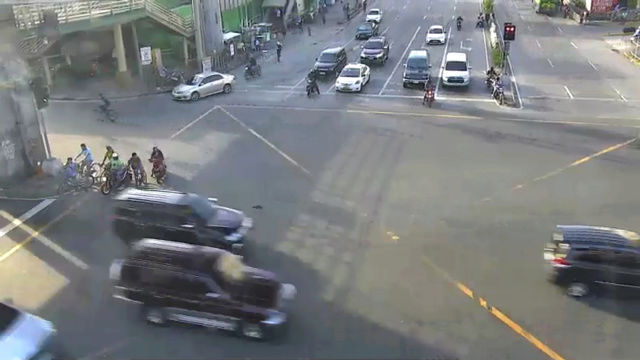I've obtained CCTV footage that establishes he was travelling at speed during collision. However, the motorcycle claims absolute right of way because he had the green light. However I'm contending I made a legal right turn with caution after first checking that the intersection was clear before I initiated my turn.
During my turn I also turned to enter the second lane as a bicycle had suddenly switched to the outermost lane, as well as a motorcycle following me showed intent to enter the lane to my right. Thus I was probably in violation of Ra 4136
Section 45. Turning at intersections. -
(a) The drive of a vehicle intending to run to the right at an intersection shall approach such intersection in the lane for traffic nearest to the right-hand side of the highway and, in turning, shall keep as close as possible to the right-hand curb or edge of the highway.
However seeing as it was a blind intersection same RA imposes a 20kph speed limit which motorcycle did not comply with. Also, moving at an unlawful speed supposedly disqualifies any right of way a vehicle operator may have.
Through crowded streets, approaching intersections at "blind corners," passing school zones, passing other vehicles which are stationery, or for similar dangerous circumstances.
20 km. per hour
Section 42. Right of way.
(a) When two vehicles approach or enter an intersection at approximately the same time, the driver of the vehicle on the left shall yield the right of way to the vehicle on the right, except as otherwise hereinafter provided. The driver of any vehicle traveling at an unlawful speed shall forfeit any right of way which he might otherwise have hereunder.
Even if he was exercising right of way..
(c) The driver of a vehicle entering a "through highway" or a "stop intersection" shall yield the right of way to all vehicles approaching to either direction on such "through highway": Provided, That nothing in this subsection shall be construed as relieving the driver of any vehicle being operated on a "through highway" from the duty of driving with due regard for the safety of vehicles entering such "through highway" nor as protecting the said driver from the consequence of an arbitrary exercise off such right of way.
I've read that proximate cause is one of the determining factors for an accident, thus while speeding is an mmda violation, swerving is not.
I've also read the following court cases and decisions to see if fault is entirely one sided.
in G.R. No. 147437 in scjudiciarygovph
Where
It is must be stressed that this restriction on speed assumes more importance where the motorist is approaching an intersection. Ordinary or reasonable care in the operation of a motor vehicle at an intersection would naturally require more precaution than is necessary when driving elsewhere in a street or highway.[57] A driver approaching an intersection is generally under duty, among others, to be vigilant and to have the vehicle under control as to be able to stop at the shortest possible notice,[58] that is, he must look for vehicles that might be approaching from within the radius that denotes the limit of danger.[59]
Since compliance with this duty is measured by whether an approaching motorist has exercised the level of precaution required under the circumstances, then with more reason that he exhibit a relatively higher level of care when the intersection is blind at the point where the roads meet. In other words, where the view at an intersection is obstructed and an approaching motorist cannot get a good view to the right or left until he is close to the intersection, prudence would dictate that he take particular care to observe the traffic before entering the intersection or otherwise use reasonable care to avoid a collision,[60]which means that he is bound is to move with the utmost caution until it is determinable that he can proceed safely and at the slowest speed possible[61] so that the vehicle could be stopped within the distance the driver can see ahead.[62]
Also
Adzuara v. Court of Appeals,[78] it was established that a motorist crossing a thru-stop street has the right of way over the one making a turn; but if the person making the turn has already negotiated half of the turn and is almost on the other side so that he is already visible to the person on the thru-street, he is bound to give way to the former.
As we were both negligent, with me as to my die turn and him as to speed, could the doctrine of last clear chance be put into play?
The doctrine of last clear chance states that where both parties are negligent but the negligent act of one is appreciably later than that of the other, or where it is impossible to determine whose fault or negligence caused the loss, the one who had the last clear opportunity to avoid the loss but failed to do so, is chargeable with the loss. Stated differently, the antecedent negligence of plaintiff does not preclude him from recovering damages caused by the supervening negligence of defendant, who had the last fair chance to prevent the impending harm by the exercise of due diligence.[69]
As he had a clear line of sight while I as the turning vehicle was unaware of him until the actual collision, wouldn’t last clear chance fall on him?
I'd much prefer to settle for a lesser amount but if he refuses and goes to litigation, what are the chances that arbitration or even the court can decide that this was a case of contributory negligence and just not award anything to both parties?
Thank you for your time.

 Home
Home



